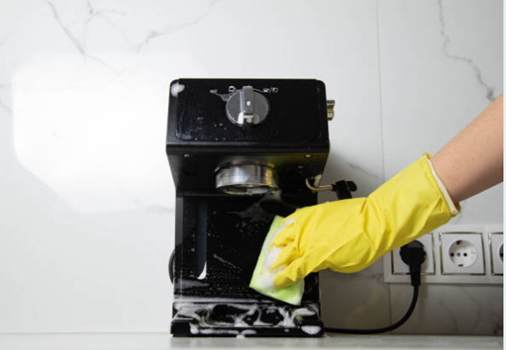Cleaning a coffee maker with vinegar is the easiest and safest way to remove oils, bacteria, and mineral buildup. You can clean it by simply mixing equal parts of white vinegar and water, running a brew cycle, and rinsing well. This quick method keeps your coffee tasting fresh and your machine working like new!

A clean coffee maker doesn’t just brew better coffee, it also keeps you healthy. Over time, coffee machines collect oils, mineral buildup, and even bacteria. According to NSF International, the coffee reservoir is one of the germiest spots in a home[1]. That’s why regular cleaning is so important.
But the good news? You don’t need fancy cleaners to fix it. Just plain white vinegar can do the job easily. In this guide, you’ll learn a step-by-step process to clean your coffee maker with vinegar. Let’s find out how to bring back fresh and bold flavor to every cup!
What You’ll Need to Clean a Coffee Pot with Vinegar?
Before you start, gather the following:
- White distilled vinegar
- Water
- Dish soap
- A soft sponge or brush
- A clean towel
- A paper filter (for drip machines)
- Optional: rice for deep cleaning the carafe
Step by Step Instructions
1- Remove and Wash Removable Parts
- Start by unplugging your coffee maker.
- Take out the carafe, filter basket, and any removable water reservoir.
- Wash them with warm, soapy water.
- Use a sponge to scrub off coffee oils or residue.
- Let all parts dry before placing them back.
Tip: If your carafe is stained, add a spoon of rice and some warm water. Swirl it around for a few minutes. The rice acts like a scrub and lifts stains naturally.
2- Make a Solution of Vinegar and Water
To make a solution, mix white vinegar and water equally. Use about:
- 1 cup vinegar
- 1 cup water
This solution helps dissolve mineral buildup inside the machine.
3- Run the Drip Cycle
- Pour the mixture of vinegar and water into the water reservoir.
- Insert an empty filter in the basket (if your machine uses one).
- Turn on the brew cycle.
- Let it run halfway through, then pause the machine for 30 minutes.
- This gives the vinegar time to sit and work its magic.
- After 30 minutes, resume and finish the cycle.
Note: You might smell strong vinegar. That’s normal—it fades during the rinse.
4- Run Rinsing Cycle with water
- Now it’s time to get rid of the vinegar taste.
- Fill the reservoir with fresh water only and run another brew cycle.
- Repeat this 2-3 times until the smell and taste are gone.
This step is important. If skipped, your next cup of coffee may taste sour and have a lingering smell of vinegar
6- Wipe down the Coffee Maker
- Don’t forget the outside! Use a damp cloth to wipe down the machine’s body, buttons, and hot plate.
- Pay special attention to crevices where dust or coffee spills may collect.
Tip: Use an old toothbrush to clean hard-to-reach spots.
Why is Vinegar a good cleaning agent?
Kills bacteria and mold: The acidity in vinegar kills germs that grow in the water reservoir and tubing[2]. It makes your coffee maker more hygienic.
Removes mineral deposits: Vinegar helps break down calcium and lime deposits inside the coffee maker. It keeps the machine running smoothly.
Natural and safe: No harsh chemicals, just simple, safe acid.
Budget-friendly: A bottle of white vinegar costs less than $2 and lasts for months.
Other Cleaning Solutions you can use instead of Vinegar
Here are a few other options to clean a coffee maker without vinegar:
- Apple Cider: It works similarly to white vinegar but has a stronger smell. Blend apple cider vinegar with water in a 1:1 ratio and rinse thoroughly.
- Baking soda: Mix 1/4 cup of baking soda with warm water and pour it into the coffee maker’s reservoir. Run a brew cycle, then rinse with clean water once or twice.
- Lemon Juice: Use lemon juice and water in 1: 2 ratio. It has natural acidity, a fresh smell, and mild antibacterial properties.
- Specialized Descaling Solution: Some commercial cleaner brands are specially formulated to remove mineral deposits. Follow the instructions on the label.
Tip: These are ideal for hard water areas or older coffee machines.
Some Expert Tips for Keeping Your Coffee Maker Clean
Cleaning your machine regularly helps it last longer and brew better coffee. Here’s how to keep it in great shape:
- Never leave used coffee grounds in the basket. They grow mold quickly.
- Use filtered water to reduce mineral buildup.
- Rinse the carafe and filter basket after every use to prevent coffee oil residue.
- Clean the carafe with rice and warm water for extra shine.
- Wipe the outside weekly to prevent dust and coffee stains.
- Deep clean once a month if you brew daily. If you use it less often, clean it every 2-3 months.
- Replace filters and parts regularly, as recommended in your user manual.
- Set a reminder on your phone or add a note to your calendar to descale your machine monthly.
Also Read:
FAQs
How Often Should You Clean Your Coffee Machine?
You should rinse removable parts daily and do a deep vinegar clean once a month. If you have hard water or use your machine heavily, clean it every 2 weeks.
How Do You Know If Your Coffee Maker Needs Descaling?
If your coffee maker is brewing slowly, making gurgling sounds, or producing lukewarm coffee, it might need descaling. A bitter or off taste in your coffee and white deposits in the water reservoir are also signs of mineral buildup. If you notice any of these, it’s time to clean your coffee maker with vinegar or a descaling solution.
What Happens If You Don’t Clean Your Coffee Maker?
When you neglect cleaning your coffee maker, it can quickly become a breeding ground for bacteria and mold. Over time, this neglect can cause your coffee to taste bitter, take longer to brew, and potentially clog the machine. In some cases, mold growth may even lead to stomach discomfort. Regular cleaning ensures your coffee tastes fresh, your machine works properly, and your coffee remains safe to drink.



